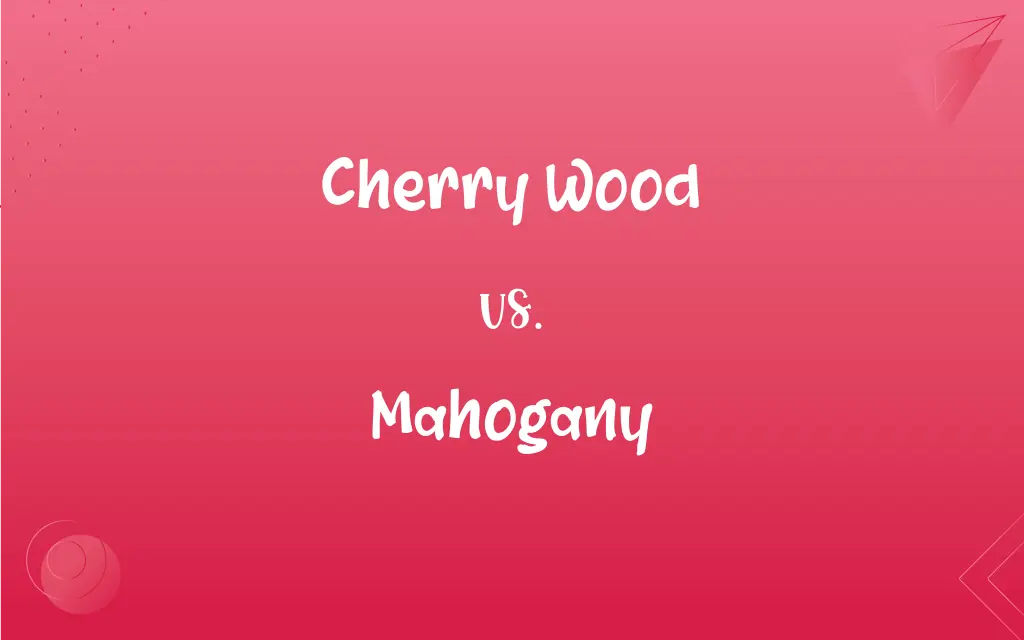Cherry Wood vs. Mahogany: What's the Difference?
Edited by Harlon Moss || By Janet White || Published on January 20, 2024
Cherry wood is a light, durable wood that darkens with age, known for its fine grain, while mahogany is a dense, tropical hardwood with a reddish-brown color, prized for its beauty and durability.

Key Differences
Cherry wood is characterized by its light to medium reddish-brown color, which deepens to a richer red over time when exposed to light. Its fine, straight grain and smooth texture make it popular for furniture and cabinetry. Mahogany, on the other hand, is known for its darker reddish-brown color, which can sometimes have a straight, fine, or medium grain. Mahogany is highly sought after for high-end furniture, boat building, and fine woodworking due to its beauty and durability.
Cherry wood is lighter in weight and density compared to mahogany, making it easier to work with for carving and detailed woodworking. It is also less expensive than mahogany, making it a more accessible option for various projects. Mahogany is heavier and denser, providing excellent strength and durability. This makes it a more expensive option, often used in luxury items and high-quality furniture.
Cherry wood originates primarily from North America and is part of the Prunus genus. It is known for its workability and compatibility with a variety of finishes, enhancing its natural beauty. Mahogany comes from tropical regions, particularly in Africa and South America, and is known for its resistance to decay and minimal shrinkage, making it ideal for outdoor and marine applications.
Cherry wood tends to have a uniform and fine texture with a natural luster, making it a preferred choice for intricate woodworking projects where appearance is crucial. Mahogany has a variable texture, often interlocked, and a moderate natural luster. It is renowned for its classic look, often associated with antique and luxury furniture.
Cherry wood is less resistant to insects and decay compared to mahogany. However, it is still durable and widely used in interior furniture and decorative items. Mahogany boasts excellent resistance to decay and insects, contributing to its use in outdoor furniture, boat building, and other applications where durability is essential.
ADVERTISEMENT
Comparison Chart
Color
Light to medium reddish-brown, darkens over time
Darker reddish-brown
Grain
Fine, straight
Straight, fine, or medium; sometimes interlocked
Weight and Density
Lighter and less dense
Heavier and denser
Origin
North America, Prunus genus
Tropical regions, Africa and South America
Uses
Furniture, cabinetry, intricate woodworking
High-end furniture, boat building, outdoor use
ADVERTISEMENT
Cherry Wood and Mahogany Definitions
Cherry Wood
Lighter and easier to work with in detailed woodworking.
The carvings were made easier with cherry wood.
Mahogany
Prized for luxury furniture and high-quality woodwork.
Mahogany was chosen for its prestige in high-end furniture design.
Cherry Wood
Sourced primarily from North America, known for its workability.
The cherry wood from this region is particularly fine-grained.
Mahogany
Often used in antiques, known for its variable texture and strength.
Antique collectors value mahogany for its strength and beauty.
Cherry Wood
A fine-grained, light reddish-brown wood that darkens over time.
The cherry wood cabinet displayed a beautiful aging process.
Mahogany
A dense, tropical hardwood with a classic reddish-brown color.
The mahogany desk had a rich, timeless look.
Cherry Wood
A popular wood for furniture and cabinetry due to its smooth texture.
We chose cherry wood for our kitchen cabinets for its elegance.
Mahogany
Heavier and more durable, ideal for outdoor and marine use.
Mahogany is favored for boat building because of its durability.
Cherry Wood
Less resistant to decay, often used for interior applications.
Cherry wood is perfect for indoor furniture due to its delicate nature.
Mahogany
Sourced from tropical regions, resistant to decay and insects.
The outdoor deck was built with mahogany for its resilience.
Mahogany
Any of several tropical American evergreen trees of the genus Swietenia of the family Meliaceae, especially S. mahagoni and S. macrophylla, valued for their hard, reddish-brown wood.
Mahogany
The wood of any of these trees, used in making furniture and musical instruments.
FAQs
What is mahogany?
A dense, tropical hardwood with a reddish-brown color, used for luxury furniture.
What is cherry wood?
A light reddish-brown wood that darkens with age, used for furniture and cabinetry.
What type of grain does mahogany have?
It can vary, often straight, fine, or medium, sometimes interlocked.
Can cherry wood be used for outdoor furniture?
It's less common due to lower decay resistance.
Is mahogany good for boat building?
Yes, its strength and decay resistance make it ideal for marine use.
Where is cherry wood commonly sourced from?
It mainly comes from North America.
Can cherry wood be used for intricate carvings?
Yes, its fine texture is ideal for detailed work.
Does cherry wood darken over time?
Yes, it deepens to a richer red when exposed to light.
Is mahogany more expensive than cherry wood?
Generally, yes, due to its density and durability.
What type of grain does cherry wood have?
It typically has a fine and straight grain.
Is cherry wood easy to work with?
Yes, its lighter weight and fine grain make it workable.
Is mahogany resistant to insects and decay?
Yes, it has excellent resistance.
Does cherry wood have a natural luster?
Yes, it has a moderate natural luster.
Does mahogany have a natural luster?
It has a moderate to high natural luster.
Where is mahogany commonly sourced from?
From tropical regions, especially Africa and South America.
How does mahogany age compared to cherry wood?
It maintains its color better, with less darkening over time.
Is cherry wood more affordable for everyday projects?
Yes, it’s more accessible than mahogany.
Why is mahogany used in high-end furniture?
Its beauty and durability make it suitable for luxury items.
Is cherry wood suitable for modern designs?
Yes, its aesthetic versatility fits various styles.
Can mahogany be used for both indoor and outdoor projects?
Yes, it’s versatile for various applications.
About Author
Written by
Janet WhiteJanet White has been an esteemed writer and blogger for Difference Wiki. Holding a Master's degree in Science and Medical Journalism from the prestigious Boston University, she has consistently demonstrated her expertise and passion for her field. When she's not immersed in her work, Janet relishes her time exercising, delving into a good book, and cherishing moments with friends and family.
Edited by
Harlon MossHarlon is a seasoned quality moderator and accomplished content writer for Difference Wiki. An alumnus of the prestigious University of California, he earned his degree in Computer Science. Leveraging his academic background, Harlon brings a meticulous and informed perspective to his work, ensuring content accuracy and excellence.







































































